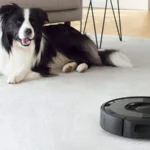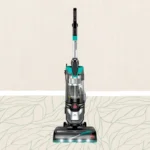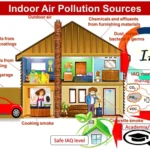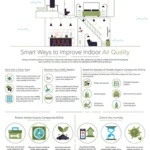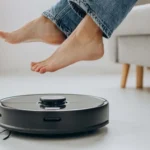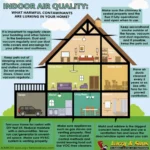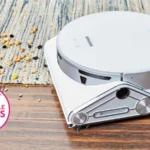Every year, millions of people suffer from allergies and asthma caused by airborne pollutants such as dust, pollen, and pet dander. Finding the right air filter can be crucial in alleviating these symptoms, but with so many filter types on the market, it can be difficult to determine which is best. Fortunately, HEPA filters have gained widespread recognition for their ability to trap small particles and improve indoor air quality. However, other filter types such as activated carbon, ionizers, electrostatic, washable, and fiberglass filters also have their own set of benefits and limitations. In this article, we will explore the world of air filters and dive into the question: “HEPA filters vs. other types of filters: which is better for allergies and asthma?”
What are HEPA Filters?
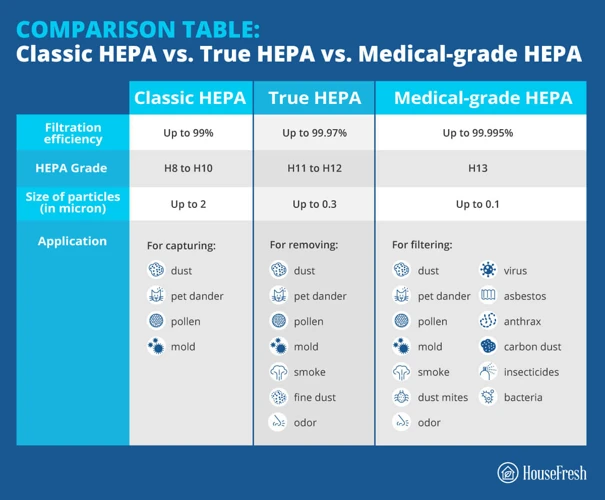
If you or someone in your home suffers from allergies or asthma, investing in a high-quality air filter is crucial. HEPA filters, or High-Efficiency Particulate Air filters, are a popular choice when it comes to air filtration. These filters are designed to remove microscopic particles, such as pollen, pet dander, and dust, from the air you breathe. HEPA filters have been used for decades and their effectiveness is well-established. Let’s take a closer look at HEPA filters and what makes them stand out among other types of air filters. If you’re interested in using HEPA filters for your vacuum cleaner, check out our article on HEPA filter vacuums.
How HEPA Filters Work
HEPA filters, or High-Efficiency Particulate Air filters, work by forcing air through a fine mesh that traps particles such as dust, pollen, pet dander, and even bacteria and viruses. The mesh is made up of randomly arranged fibers made of materials like fiberglass, which are tightly woven together to create a barrier that captures the particles.
To understand how HEPA filters work, it’s important to know that they are classified based on their level of efficiency in capturing particles. According to standards set by the U.S. Department of Energy, a true HEPA filter must capture at least 99.97% of particles that measure 0.3 microns in diameter or larger. For reference, a human hair is about 50 microns in diameter, while pollen particles range from 10 to 100 microns in diameter.
The table below summarizes how HEPA filters work:
| Filter Type | Size of Particles Filtered | Efficiency |
|---|---|---|
| HEPA Filters | 0.3 microns and larger | 99.97% |
| Activated Carbon Filters | Chemicals, gases, and odors | Varies |
| Ionizers/UV Lights | 0.01 microns and larger | Varies |
| Electrostatic Filters | 0.3 microns and larger | Varies |
| Washable Filters | Large particles (e.g. pet hair) | Varies |
| Fiberglass Filters | Large particles (e.g. lint, pollen) | Varies |
HEPA filters work using three mechanisms: interception, impaction, and diffusion. Interception occurs when particles in the air flow come close to a fiber in the filter and stick to it. Impaction happens when larger particles cannot avoid the fibers and collide with them, getting stuck. Finally, diffusion is when smaller particles move in a zigzag fashion and collide with gas molecules, causing them to slow down and get trapped in the fibers.
HEPA filters are commonly used in air purifiers, vacuum cleaners, and HVAC systems. They can greatly improve indoor air quality, especially for those who suffer from allergies or asthma. In fact, studies have shown that using HEPA filters can reduce symptoms of these conditions.
If you’re interested in learning more about HEPA filters in vacuum cleaners, check out our article on HEPA filtration and smart vacuums for asthma.
Benefits of HEPA Filters
HEPA filters have several benefits that make them an ideal choice, especially for individuals suffering from allergies and asthma. Below are some of the benefits of HEPA filters that you should know:
| Benefits | Explanation |
|---|---|
| Eliminates Airborne Allergens | HEPA filters can remove 99.97% of airborne allergens as small as 0.3 microns. This includes pet dander, mold, pollen, dust mites, and other tiny particles that can trigger asthma and allergic reactions. |
| Traps Harmful Particles | HEPA filters can capture harmful particles such as asbestos, lead, and other pollutants that may cause health problems. These filters can help remove harmful substances from the air, making it safer to breathe. |
| Long Life Span | HEPA filters require less frequent replacement compared to other types of filters. Depending on the usage and the quality of the filter, HEPA filters can last up to several years, making them cost-effective in the long term. |
| Improves Indoor Air Quality | HEPA filters help to improve the indoor air quality by removing pollutants and allergens. This can help reduce the risk of respiratory problems and improve overall health and well-being. |
| Effective Filtration | HEPA filters work with high efficiency and can trap a high percentage of harmful particles. Their advanced filtration system makes them effective in removing even the tiniest of pollutants. |
| Smart Vacuum Compatibility | HEPA filters are compatible with smart vacuums that have HEPA filtration systems. These smart vacuums can help reduce indoor air pollution by capturing and trapping allergens and pollutants in the air. |
HEPA filters are ideal for individuals with allergies and asthma as they can remove a large percentage of airborne allergens, improve indoor air quality, and filter harmful particles. Smart vacuums with HEPA filtration systems can further help reduce indoor air pollution. The use of HEPA filtration is a recommended way to effectively clean the air in your home.
Limitations of HEPA Filters
While HEPA filters are widely known for their efficiency, they do come with some limitations. Here are some of the most notable ones:
- Not Effective Against Gases and Odors: HEPA filters are designed to remove microscopic particles from the air, but they cannot effectively remove gases, smoke or unpleasant odors.
- Need to be Replaced Regularly: Over time, HEPA filters become clogged with the particles they capture, which reduces their effectiveness. Replacement is typically necessary every 6 – 12 months, depending on usage.
- Can Be Costly: Compared to other types of filters, HEPA filters can sometimes be more expensive. However, it’s worth noting that they can also be more effective at removing particles, making them a valuable investment for individuals with allergies or asthma.
- May Restrict Airflow: While HEPA filters are effective at removing allergens, pet dander, dust and other particles, they can sometimes restrict airflow, making it harder for your HVAC system to distribute air throughout your home.
- May Not Fit in All HVAC Systems: HEPA filters are larger and thicker than some other filter options, which means they may not fit in all HVAC systems. Be sure to check compatibility before purchasing a HEPA filter.
It’s important to be aware of the limitations of any air filter you’re considering, but don’t let them discourage you from investing in a HEPA filter that can greatly improve the air quality in your home. If you’re ready to upgrade to a smart vacuum with HEPA filters, check out the latest smart vacuums with HEPA filters to keep your home clean and healthy.
Other Types of Filters
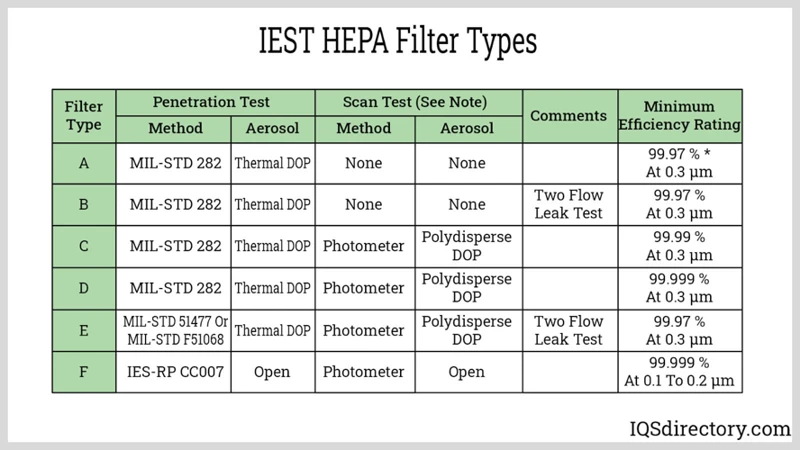
When it comes to air purifiers, there are various types of filters available on the market to choose from. Understanding the difference between these filters is important to find the best solution for your needs. In addition to HEPA filters, other types of filters include Activated Carbon Filters, Ionizers/UV Lights, Electrostatic Filters, Washable Filters, and Fiberglass Filters. Each filter type has its own set of strengths and weaknesses, so it’s important to consider what you’re hoping to achieve with an air filter. Let’s dive deeper into each type of filter to see how they work and how they compare to HEPA filters.
Activated Carbon Filters
Activated carbon filters are another popular type of air filter used for allergies and asthma. These filters are particularly effective at reducing odors and capturing volatile organic compounds (VOCs) from the air. They are made by bonding activated carbon onto a synthetic fiber mesh.
How Activated Carbon Filters Work: When air passes through an activated carbon filter, the carbon molecules attract and trap chemical pollutants and odors like a sponge. These filters use adsorption, which is the process of binding particles to the surface of the carbon. It’s important to note that while activated carbon filters can remove certain pollutants, they cannot remove larger particles like dust and allergens.
Benefits of Activated Carbon Filters: One of the main benefits of activated carbon filters is their ability to remove unpleasant odors from the air. They can also remove harmful VOCs that may be present in household cleaning products, paints, and pesticides. Additionally, activated carbon filters can extend the life of HEPA filters by capturing larger particles like pet hair and dust.
Limitations of Activated Carbon Filters: Activated carbon filters are not effective in removing allergens and larger particles from the air. They also need to be replaced more often than HEPA filters to maintain their effectiveness. The average lifespan of an activated carbon filter is around three months.
When it comes to choosing the best type of filter for allergies and asthma, it’s important to consider your individual needs and the specific pollutants in your environment. While activated carbon filters are effective at removing certain pollutants, they should be used in combination with other filters like HEPA for maximum efficiency.
To learn more about HEPA filters, read our article on “HEPA Filter for Smart Vacuums” or “Clean Smart Vacuum with HEPA Filter.”
Ionizers/UV Lights
Another type of filter commonly used for allergies and asthma are ionizers and UV lights. These types of filters work by using charged plates or UV-C light to kill bacteria and viruses that may be present in the air.
| Advantages of Ionizers/UV Lights | Disadvantages of Ionizers/UV Lights |
|---|---|
|
|
While ionizers and UV lights can be effective at eliminating harmful bacteria and viruses, they may not be the best choice for those with allergies and asthma. These types of filters do not remove larger particles such as dust and pet dander that can aggravate allergy and asthma symptoms. Additionally, some models of ionizers can produce ozone, which can be harmful to human health if inhaled in high concentrations.
It is important to carefully consider the benefits and drawbacks of each type of filter before choosing the best option for your allergies and asthma. For most people, a HEPA filter is the best choice due to its proven effectiveness and ability to remove the largest range of particles.
Electrostatic Filters
Electrostatic filters are another option for those with allergies and asthma. These filters are different from HEPA filters and work by creating an electrostatic charge that attracts and traps particles.
How Electrostatic Filters Work: Electrostatic filters use static electricity to attract particles to the filter. They usually have two layers of vented metal that are separated by a layer of polypropylene. When air passes through the polypropylene layer, it creates an electrostatic charge that attracts particles to the filter.
Benefits of Electrostatic Filters: Electrostatic filters have a few benefits over other types of filters. They are reusable and last for a long time, as they can be cleaned rather than replaced. They also do not produce any ozone or other harmful byproducts.
Limitations of Electrostatic Filters: One limitation of electrostatic filters is that they are not as effective as HEPA filters at trapping small particles. Additionally, while they are reusable, they do require regular cleaning to maintain their efficiency.
| Benefits | Limitations | |
|---|---|---|
| Electrostatic Filters | Reusable, long-lasting Doesn’t produce ozone |
Less effective at trapping small particles Requires regular cleaning |
Conclusion: While electrostatic filters have some benefits, they may not be the best choice for those with allergies and asthma. HEPA filters are generally more effective at trapping small particles, which can aggravate allergies and asthma symptoms. However, electrostatic filters may still be a good option for those who want a reusable and low-maintenance filter.
Washable Filters
Washable filters, also known as reusable filters, are a more eco-friendly alternative to disposable filters. They are made from materials such as foam, polyester, or cotton, and can be washed and reused multiple times.
Benefits: The primary benefit of washable filters is their reusability, which helps reduce waste and save money over time. They also tend to be more durable than disposable filters, and can withstand multiple washings without losing their effectiveness.
Limitations: While washable filters may seem like a great option, they do have some limitations to consider. Firstly, they may not be as effective at removing small particles as disposable filters or HEPA filters. Additionally, if they are not washed and maintained regularly, they can accumulate dirt and bacteria, which can worsen asthma and allergy symptoms.
Here is a table comparing the benefits and limitations of washable filters:
| Benefits | Limitations | |
|---|---|---|
| Reusability | + | |
| Durability | + | |
| Effectiveness at removing small particles | – | |
| Accumulation of dirt and bacteria if not washed regularly | – |
Overall: While washable filters have their benefits, they may not be the best option for those with asthma or allergies. HEPA filters or disposable filters may be more effective at removing small particles and preventing the accumulation of dirt and bacteria. However, for those who prioritize sustainability and cost-effectiveness, washable filters may be a good choice, as long as they are maintained properly.
Fiberglass Filters
Fiberglass filters are the most basic and commonly used types of air filters. They are made of layered fiberglass fibers that capture large airborne particles. These filters are typically disposable because they are unable to trap smaller particles like pollen, spores, or bacteria.
Benefits
– Fiberglass filters are cheap and readily available.
– They help trap dust and other larger particles from the air.
Limitations
– They are not very efficient in trapping smaller particles.
– They need to be replaced frequently, which can become expensive in the long run.
– They can actually do more harm than good as they do not filter bacteria or viruses and could recirculate them back into the air.
| Filter Type | Efficiency | Cost | Lifespan |
|---|---|---|---|
| Fiberglass Filters | Low | Low | 1-3 Months |
While fiberglass filters can help with capturing larger particles, they are not recommended for people who suffer from allergies or asthma. They are not effective in capturing smaller pollutants and other harmful particles that can lead to respiratory issues. Most importantly, the fiberglass filter should be changed out every 1-3 months to keep the air quality relatively clean.
For people suffers who suffer from allergies and asthma, it would be best to invest in a filter that has a higher efficiency such as HEPA, activated carbon, or electrostatic filters that could truly benefit them, their families, and their breathing habits.
Which Filter is Best for Allergies and Asthma?
When it comes to managing allergies and asthma, choosing the right air filter can make a big difference. With so many options available, it can be overwhelming to determine which one will be the most effective. In this section, we’ll break down the pros and cons of HEPA filters, activated carbon filters, ionizers/UV lights, electrostatic filters, washable filters, and fiberglass filters, giving you the information you need to make an informed decision about which filter is the best fit for your needs. Let’s dive in and explore each option in detail.
HEPA Filters
When it comes to allergies and asthma, HEPA filters are often considered the gold standard. These filters are highly effective at capturing small particles, including things like pollen, pet dander, and dust mites. Here are some key facts about HEPA filters:
- HEPA stands for high efficiency particulate air.
- These filters are made of dense fibers that can capture tiny airborne particles.
- HEPA filters can capture up to 99.97% of particles that are 0.3 microns or larger.
- They can also capture smaller and larger particles with a slightly lower efficiency.
One of the biggest benefits of HEPA filters is their ability to reduce allergens in the air. This can be especially helpful for people with allergies or asthma, as airborne particles can trigger symptoms such as coughing, wheezing, and sneezing. By removing these particles from the air, HEPA filters can help improve indoor air quality and reduce symptoms.
It’s worth noting that HEPA filters do have some limitations. For example, they are less effective at capturing odors and gases, which may require the use of additional filters or air purifiers. Additionally, HEPA filters can be quite expensive, and they may not fit all types of HVAC systems or air purifiers.
Despite these limitations, for those with allergies and asthma, HEPA filters remain a top choice for improving indoor air quality and reducing symptoms.
Activated Carbon Filters
Activated carbon filters are a type of filter that use activated carbon to remove impurities and odors from the air. This type of filter is particularly effective at removing chemicals and gases, such as those found in household products, smoke, and cooking odors.
How Activated Carbon Filters Work
Activated carbon is a form of carbon that is processed to have small pores which increase its surface area, making it effective in adsorbing impurities. When air passes through an activated carbon filter, the impurities in the air are absorbed onto the surface of the activated carbon.
Benefits of Activated Carbon Filters
Activated carbon filters have several benefits. Firstly, they are very effective at removing volatile organic compounds (VOCs) which can cause health problems. Secondly, they can also remove unpleasant smells and odors from the air, making the environment more pleasant to be in. Additionally, activated carbon filters are relatively cheap and easy to replace, making them a cost-effective solution for many households.
Limitations of Activated Carbon Filters
Activated carbon filters have limitations. They are less effective at removing particulate matter, which includes common allergens like pollen and dust. This means that they alone may not be sufficient for someone with allergies or asthma. Additionally, activated carbon filters require regular replacing, otherwise they can become saturated and stop being effective.
Activated carbon filters are a great addition to any air filtration system, especially for people who are concerned with air quality and eliminating odors. However, for those who suffer from allergies or asthma, it is recommended to use a HEPA filter in conjunction with an activated carbon filter for maximum effectiveness.
Ionizers/UV Lights
Ionizers and UV lights are different types of air filters that work by releasing ions into the air or using ultraviolet light to kill airborne pollutants. While they are effective at removing some particles in the air, they have limitations that make them less suitable for people with allergies and asthma.
Ionizers
Ionizers work by releasing negatively charged ions into the air, which attach to positively charged particles such as dust, pollen, and mold spores, causing them to clump together and fall to the ground. While this can effectively remove some pollutants from the air, ionizers also produce ozone which can be harmful to people with asthma and other respiratory problems. Additionally, ionizers do not remove larger particles such as pet dander, which can still trigger allergies and asthma symptoms.
UV Lights
UV lights work by using ultraviolet radiation to kill bacteria, viruses, and other microorganisms that are present in the air. While UV lights are effective at killing a wide variety of germs, they do not remove particles from the air the way that HEPA filters do. They also require constant maintenance to ensure that they are functioning properly, and can be expensive to replace if they break down.
Conclusion
While ionizers and UV lights can be beneficial in certain situations, they are not the best choice for people with allergies and asthma who need comprehensive air filtration. HEPA filters are the gold standard for air purification and are highly effective at removing a wide range of pollutants from the air. They are also safe for people with respiratory problems and do not produce any harmful byproducts. If you or someone in your household suffers from allergies or asthma, investing in a high-quality HEPA filter is a smart choice that can help improve your overall health and well-being.
Electrostatic Filters
Electrostatic filters are another option that you might come across when researching air filters for allergies and asthma. These filters work by creating an electrostatic charge that attracts and captures particles. Let’s take a closer look at the benefits and limitations of electrostatic filters:
Benefits:
- Effective at capturing smaller particles, such as bacteria and viruses.
- Can be washed and reused, which saves money in the long run.
- Does not produce ozone like ionizers do, which can be harmful to people with respiratory issues.
Limitations:
- Less effective at capturing larger particles like pollen and pet dander compared to HEPA filters.
- The electrostatic charge may wear off over time, reducing the effectiveness of the filter.
- May produce a static electricity buildup that can cause discomfort or damage to electronic equipment nearby.
Electrostatic filters can be a good option for those looking to capture smaller particles and save money through reuse. However, they may not be as effective at capturing larger particles and do come with some limitations to keep in mind.
Washable Filters
When it comes to washable filters, they are typically made of foam or specially designed materials that are able to be washed and reused multiple times, making them an eco-friendly option. These filters work by trapping particles as air passes through them, but they will eventually clog and require cleaning.
One benefit of washable filters is that they are cost-effective in the long run since they can be reused, eliminating the need for constant replacements. They can also be useful for reducing waste and minimizing your eco-footprint. Additionally, washable filters can come in different sizes, making them adaptable to various types of air conditioning or heating systems.
However, washable filters may not be the best option for those with allergies and asthma. They are not as effective in trapping small particles compared to HEPA filters, and may not provide the same level of air quality particularly for those who suffer from allergies or asthma.
Pros:
- Cost-effective in the long run
- Eco-friendly since they can be reused
- Available in different sizes
Cons:
- Not as effective in trapping small particles as HEPA filters
- May not provide the same level of air quality for those with allergies or asthma
Washable filters can be a good option for those looking for an eco-friendly and cost-effective option for their air purifying needs. But for those with severe allergies and asthma, a HEPA filter may be a better choice for maximum air quality.
Fiberglass Filters
Fiberglass filters are one of the most commonly used types of filters in homes and businesses. These filters are made from spun glass and work by capturing large particles like dust and dirt as they pass through the filter. Unlike HEPA filters, they are not as efficient at capturing smaller particles like pollen or pet dander.
Here is a table that will help in comparing fiberglass filters to other types of filters:
| Filter Type | Efficiency in Capturing Particles | Lifespan | Cost |
|---|---|---|---|
| Fiberglass Filters | Efficient at capturing large particles such as dust and dirt. Less efficient at capturing smaller particles like pollen or pet dander. | Typically need to be replaced once a month. | Low cost compared to other types of filters. |
| Activated Carbon Filters | Can remove some gases, odors, and volatile organic compounds (VOCs) from the air in addition to larger particles. | Need to be replaced every three to six months. | Moderate to high cost depending on the size and quality of the filter. |
| Ionizers/UV Lights | Produce negative ions or use UV light to remove particles from the air. Less effective at removing larger particles like dust. | Can last for several years with proper maintenance. | Can be low to high cost depending on the type and quality. |
| Electrostatic Filters | Use static electricity to attract and capture particles, including smaller ones like pollen and pet dander. | May need to be replaced every three months to one year. | Low to moderate cost depending on the quality and brand of the filter. |
| Washable Filters | Can be washed and reused multiple times. | Can last for several years with proper maintenance. | Low to moderate cost depending on the type and quality. |
Fiberglass filters are a cost-effective option for capturing large particles in the air. However, if you are looking for a filter that can capture smaller particles like pollen and pet dander, then you may want to consider a more efficient option like a HEPA filter or electrostatic filter.
Conclusion
After evaluating the different types of filters and their effectiveness in managing allergies and asthma symptoms, it’s clear that HEPA filters are the best option. HEPA filters are capable of capturing a wide range of allergens and irritants, including pet dander, dust mites, pollen, and bacteria, that are known to exacerbate allergy and asthma symptoms.
While other filters such as activated carbon filters and ionizers/UV lights may be effective at capturing certain particles or eliminating odors, they do not have the same level of performance as HEPA filters in capturing the wide range of allergens and irritants that cause allergies and asthma symptoms.
Electrostatic filters and washable filters may be a more affordable option for people on a budget, but they do not have the same level of filtration as HEPA filters. Additionally, washable filters can become breeding grounds for mold and bacteria if not cleaned and maintained properly.
Lastly, fiberglass filters are the least effective choice when it comes to managing allergies and asthma symptoms. They are only capable of capturing larger particles such as dust and debris, and do not capture the smaller allergens and irritants that can cause symptoms.
In conclusion, if you or someone in your family suffers from allergies or asthma, investing in a HEPA filter is a smart choice to make. With their superior filtration capabilities, HEPA filters can help improve indoor air quality and reduce allergy and asthma symptoms.
Frequently Asked Questions
What is a HEPA filter made of?
A HEPA filter is typically made of thin layers of pleated and interlaced borosilicate glass fibers, which are assembled to create a dense filter that traps fine particles.
How often should HEPA filters be replaced?
HEPA filters should typically be replaced every 6 to 12 months, depending on usage and environmental factors such as air quality.
What are the benefits of activated carbon filters?
Activated carbon filters are effective at removing odors, harmful gases, and volatile organic compounds from the air, making your indoor air cleaner and fresher.
What are ionizers/UV lights?
Ionizers and UV lights are air purification technologies that use negative ions or ultraviolet light to neutralize airborne pollutants such as mold, bacteria, and viruses.
What are the benefits of electrostatic filters?
Electrostatic filters are effective at trapping small particles such as pollen, pet dander, and dust, and they are washable and reusable, making them a cost-effective choice.
What are washable filters?
Washable filters are reusable filters made of synthetic materials, such as polyester or foam, that can be washed and reused multiple times before they need to be replaced.
What are the limitations of fiberglass filters?
Fiberglass filters are less efficient at trapping small particles, such as pollen and bacteria, and they don’t last as long as other types of filters, making them a less desirable option for allergy and asthma sufferers.
Are HEPA filters effective at reducing allergens?
HEPA filters are highly effective at reducing allergens, such as pollen, dust mites, and pet dander, making them a top choice for people with allergies or asthma.
Are ionizers/UV lights safe for pets and humans?
Ionizers and UV lights are generally safe for pets and humans, although some individuals may experience irritation or allergies if exposed to the negatively charged ions or UV light for extended periods.
What is the best type of filter for allergies and asthma?
HEPA filters are considered the best option for people with allergies or asthma, as they are highly effective at trapping allergens and other airborne pollutants.

